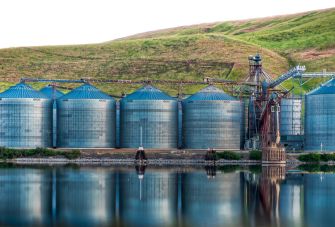ETP Food and Beverage
At Hydro Water Industries, we provide a comprehensive range of Effluent Treatment Plants (ETPs) specifically tailored for the food and beverage industry. Wastewater generated by this sector typically contains a high load of hazardous contaminants such as:

Suspended and total solids
BOD (Biological Oxygen Demand)
COD (Chemical Oxygen Demand)
Edible oils and grease
Sugar and starch residues
Preservatives, colours, and organic compounds
Untreated, this wastewater poses a serious threat to the environment and public health. Therefore, government regulations mandate its proper treatment before discharge. Our state-of-the-art ETP systems ensure full compliance with PCB (Pollution Control Board) norms, and facilitate safe reuse and eco-friendly discharge.
ETP for Food and Beverage Industry
As a leading ETP manufacturer based in Delhi NCR, Hydro Water Industries brings nearly a decade of experience and excellence to the field of effluent treatment. We offer various system configurations—manual, semi-automatic, and fully automatic—and employ multiple treatment methods, including:
Physical Treatment
Chemical Treatment
Biological Treatment
Our standard ETPs generally follow four levels of treatment:
1. Preliminary Treatment
Larger solids are removed through coarse screening, grit chambers, and crushers to break down solid waste. The goal is to prepare the effluent for further processing.
2. Primary Treatment
This stage includes gross filtration to remove 50–60% of suspended solids, including oils, fats, and nutrients like nitrogen and phosphorus bound to these solids.
3. Secondary Treatment
Involves aerobic and anaerobic biological processes such as activated sludge treatment, which uses microorganisms in an oxygen-rich environment to decompose biodegradable material.
4. Tertiary (Final) Treatment
Advanced treatment technologies are used to remove remaining contaminants. This stage may include:
Chlorination
UV disinfection
Ozonation
After this step, the water is free of all harmful pollutants and safe for discharge or reuse.
Wastewater and Treated Water Characteristics
| SN | Item | Before Treatment | After Treatment |
|---|---|---|---|
| 1 | Temperature | 25°C to 35°C | Not to exceed 5°C above ambient |
| 2 | Colour | Light yellowish | Colourless |
| 3 | Odour | Present (light) | Nil |
| 4 | pH | NA | 6.5 to 8 |
| 5 | TSS | NA | <30 mg/l |
| 6 | Oil and Grease | NA | <10 mg/l |
| 7 | BOD | NA | <30 mg/l |
| 8 | COD | NA | <150 mg/l |
Note: As BOD load is evenly distributed in the daily discharge, no separate BOD removal is suggested.
Treatment Process Flow
Effluent from all sources is collected in an underground equalization tank.
It is screened using a bar screen and passes through an oil and grease trap.
Air agitation ensures homogeneity.
Effluent is pumped into a flash mixer, where coagulants and chemicals are dosed using automatic dosing pumps.
Mixed water flows into a clari-flocculator.
Flocculants are added to form flocs which settle in a tube settler (inclined PVC tubes at 60°).
Sludge is dewatered using sludge drying beds or filter press, and the resulting sludge cakes are sent to PCB-authorized landfill.
Clarified water is passed to biological treatment, followed by:
Dual Media Filter (DMF) for TSS removal
Activated Carbon Filter (ACF) for odor and color removal
Final water is collected in treated water holding tanks for safe discharge or reuse.
Scope of Supply
A. Primary Treatment Section
| Item | Quantity |
|---|---|
| Bar Screen | 01 No. |
| Effluent Transfer Pump | 01 No. |
| Air Blower | 01 No. |
| Aeration Grids | 01 Lot |
| Packaged Treatment Unit | 01 Set |
| Chemical Dosing Systems | 03 Sets |
| Filter Feed Tank | 01 No. |
B. Secondary Treatment Section
| Item | Quantity |
|---|---|
| Filter Feed Pump | 01 No. |
| Dual Media Filter (DMF) | 01 No. |
| Activated Carbon Filter | 01 No. |
| Filter Feed Tank | 01 No. |
| Chlorine Dosing System | 01 Set |
C. Other Items
| Item | Quantity |
|---|---|
| Piping and Instrumentation | As per P&ID |
| Treated Water Storage Tanks | 02 Nos. |
| Transfer Pump (1.5 HP) | 02 Nos. |
| Transfer Pump (7.5 HP) | 01 No. |
| Control Panel & Internal Cabling | 01 Lot |
Salient Features
Continuous-flow ETP designed for rinsing and cleaning stages in food processing.
Below-ground installation for bar screen chamber, oil & grease trap, storage tanks to optimize floor space.
Tanks constructed using MSEP (Mild Steel with Epoxy Paint) for durability.
Treated water suitable for reuse in toilet flushing, floor cleaning, horticulture etc.
Compliant with PCB norms for discharge.
Entire ETP system is supplied within battery limits (from effluent inlet to treated water outlet).
Power and water supply to be provided by the client.
In-house sampling report included. Third-party testing can be arranged at additional cost.
Enquiry Number
+91 93690-75730
hydrowaterindustries@gmail.com
Address
Kh. No.608/1, Asaudha, Balaji Industrial Area Bahadurgarh, Haryana
